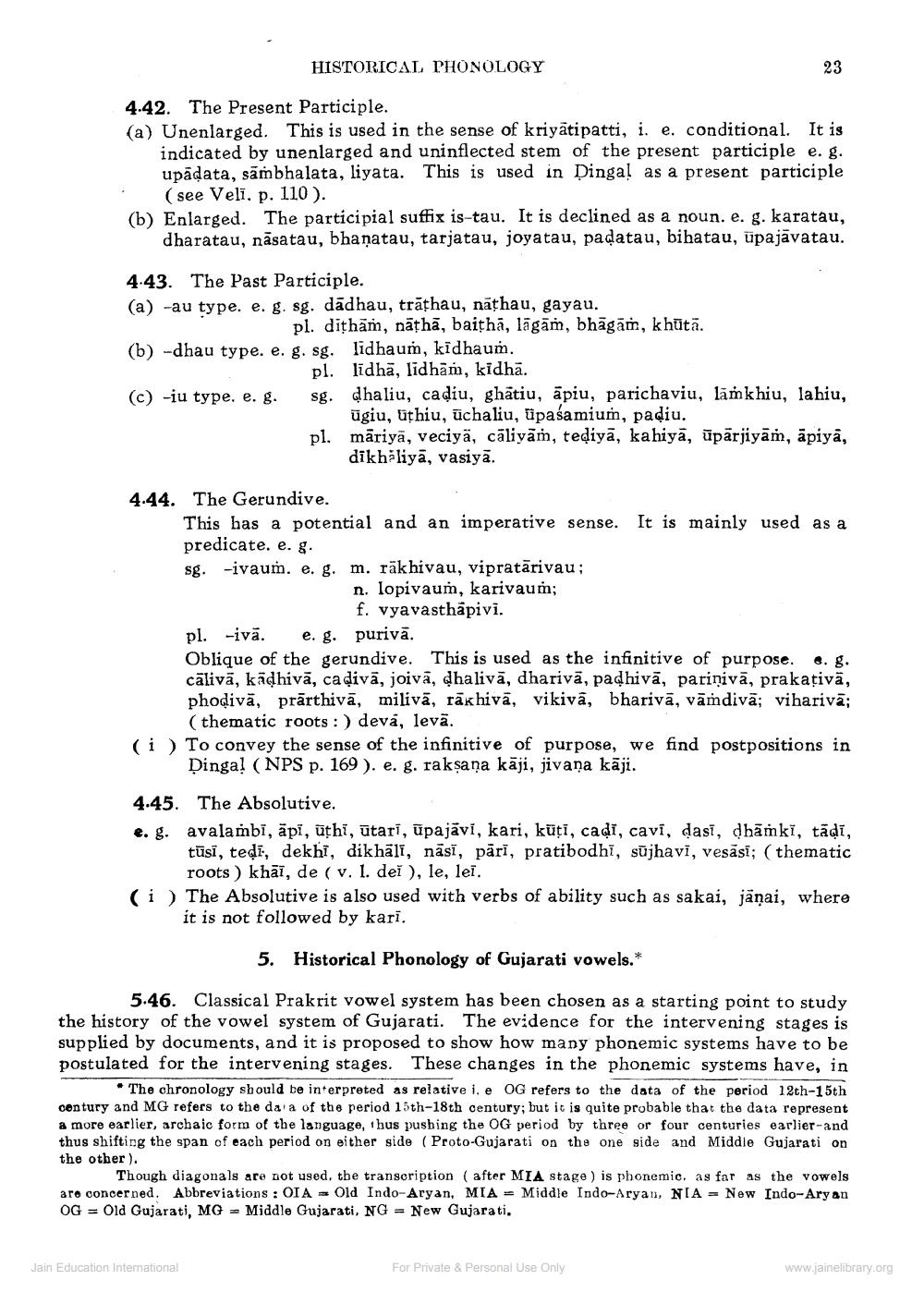________________
HISTORICAL PHONOLOGY
4.42. The Present Participle. (a) Unenlarged. This is used in the sense of kriyatipatti, i. e. conditional. It is
indicated by unenlarged and uninflected stem of the present participle e. g. upadata, sambhalata, liyata. This is used in Dinga! as a present participle
(see Veli. p. 110). (b) Enlarged. The participial suffix is-tau. It is declined as a noun. e. g. karatau,
dharatau, nāsatau, bhaņatau, tarjatau, joyatau, padatau, bihatau, üpajavatau.
4.43. The Past Participle. (a) -au type. e. g. sg. dādhau, trāthau, näthau, gayau.
pl. ditham, nāthā, baithā, lāgām, bhāgām, khütā. (b)-dhau type. e. g. sg. lidhaum, kīdhaum.
pl. lidhā, lidhām, kidha. (c) -iu type. e. g. sg. dhaliu, cadiu, ghātiu, āpiu, parichaviu, länk hiu, lahiu,
ügiu, uthiu, ūchaliu, üpasamium, padiu. pl. māriyā, veciyä, cāliyām, tediyā, kahiyā, ūpārjiyām, āpiya,
dikhăliyā, vasiyā.
4.44. The Gerundive.
This has a potential and an imperative sense. It is mainly used as a predicate. e. g. sg. -ivaum. e. g. m. räk hivau, vipratārivau;
n. lopivaum, karivaum;
f. vyavasthäpivi. pl. -ivā. e. g. purivā. Oblique of the gerundive. This is used as the infinitive of purpose. e. g. cālivā, kādhivă, ca divā, joiva, dhalivă, dharivā, padhivā, pariniva, prakațivä, phodivā, prārthivā, milivā, rākhivā, vikiva, bharivā, vāmdivā; viharivā;
(thematic roots :) deva, levā. (i) To convey the sense of the infinitive of purpose, we find postpositions in
Dinga! ( NPS p. 169 ). e. g. raksana kāji, jivana kāji.
4.45. The Absolutive. e. g. avalambi, āpi, ūțhi, ūtari, ūpajavi, kari, küți, cadi, cavi, dasī, dhāmki, tādi,
tūsī, tedi, dekhi, dikhālī, nāsī, pārī, pratibodhi, sūjhavi, vesāsi; (thematic
roots ) khai, de (v. 1. dei ), le, lei. (i ) The Absolutive is also used with verbs of ability such as sakai, jāņai, where
it is not followed by kari.
5. Historical Phonology of Gujarati vowels.*
5.46. Classical Prakrit vowel system has been chosen as a starting point to study the history of the vowel system of Gujarati. The evidence for the intervening stages is supplied by documents, and it is proposed to show how many phonemic systems have to be postulated for the intervening stages. These changes in the phonemic systems have, in
• The chronology should be interpreted as relative i, e OG refers to the data of the period 12th-15th century and MG refers to the da'a of the period 15th-18th century; but it is quite probable that the data represent a more earlier, archaic form of the language, thus pushing the OG period by three or four centuries earlier-and thus shifting the span of each period on either side (Proto-Gujarati on the one side and Middle Gujarati on the other).
Though diagonals are not used, the transcription (after MIA stage) is phonemic, as far as the vowels are concerned. Abbreviations : OIA = Old Indo-Aryan, MIA = Middle Indo-Aryan, NIA = New Indo-Aryan OG = Old Gujarati, MG Middle Gujarati, NG = New Gujarati.
Jain Education International
For Private & Personal Use Only
www.jainelibrary.org




